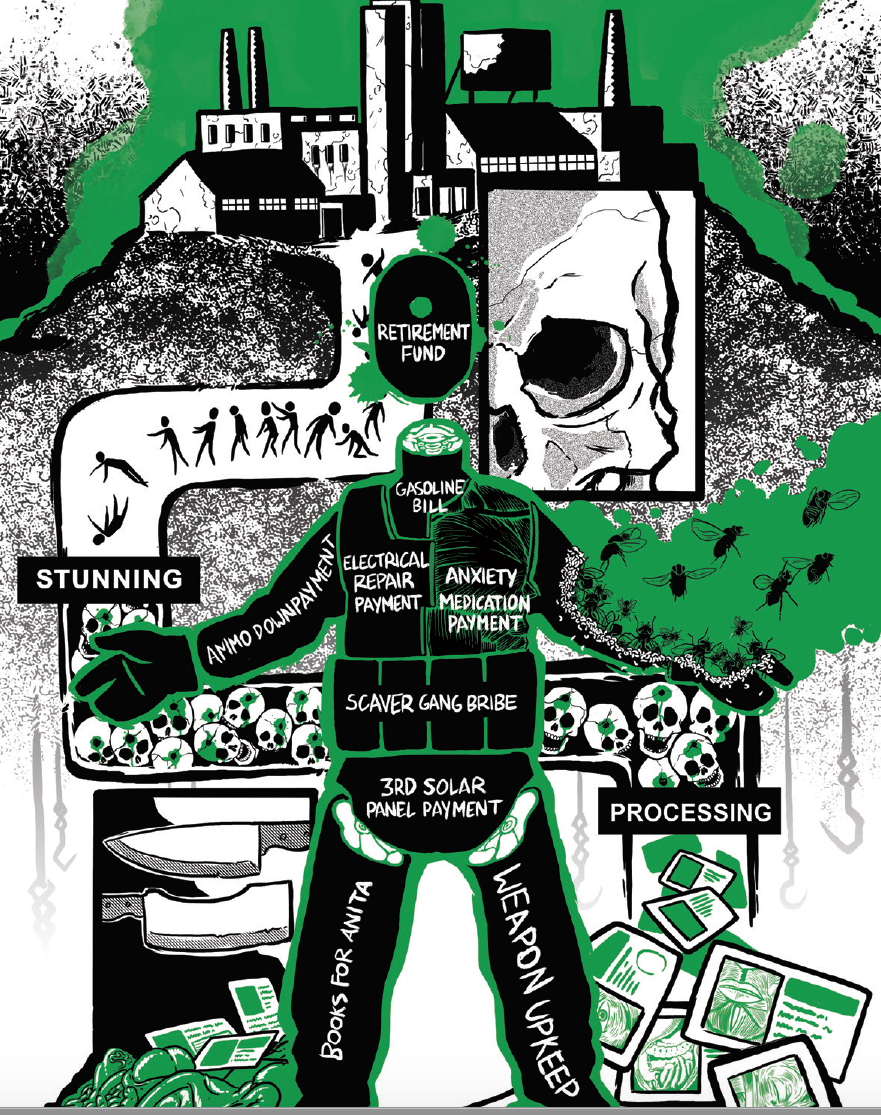One thing I’m concerned about is recording equipment leaving identifiable information without us knowing about it.
Well just recently learned that some printers exfiltrate data from air gapped networks through ink cartridges.
Any proof of this just sounds like BS. Even your source doesn’t proof what you are saying. Echo devices ring doorbells nothing about fire tvs.
No where does it state that customer data is being sent to Amazon. And neither that the technology is implemented in Amazon TVs.
Thanks for giving false info or inaccurate source.
At launch (in 2021) the FireTV was not on the list of Sidewalk-enabled products, but given the fact that Sidewalk was enabled without user consent on many existing devices (and has been found to re-enable itself after being disabled) combined with the fact that FireTV devices all have at least the necessary bluetooth radio (even if not the LoRA part, Sidewalk can use both/either) and thus could become sidewalk-enabled by a software update in the future… I would still say that Sidewalk is a reason (among many) to boycott FireTV along with the rest of Amazon’s products.
The takeaway that Amazon built their own mesh network so that their products in neighboring homes can exfiltrate data via eachother whenever any one of them can get online is not false.
I see. Although none of that was listed in the Wikipedia article
Most modern cars are SIM-enabled and are constantly sending data back to the mothership. But even those that aren’t will still collect data locally and that data will be collected when you send the car to an “official/licenced/authorized” repair shop.
I hate this.
I’m still driving a '99 vehicle and the most advanced thing about it are the power windows. I dread upgrading to a vehicle that can break in so many new ways. I hate that everything has touch screens and the software on many is awful and if it breaks, surprise, you have no music in your car now.
Those still have an ECU that stores most of the same data. It knows you speed, it knows how hard you brake, etc. anything with an OBD will store data. And that’s carssince the 70s
deleted by creator
You’ll be surprised, they take snapshots at certain points. In a collision all vehicles will store last 5 or so seconds of data, speed, see if brakes are engaged, stuff like that, it’s all used in collision investigations. There’s not a single car I think that’s doesn’t do this. As I said, it’s in some form, but your vehicle does know if you’ve sped if it has an obd on it.
What do you think basic OBD stuff is? It’s all that information and that’s used to see if anything’s wrong with the vehicle.
deleted by creator
No, even ODB from the 70s records you max reached speed, if you’ve hit the governer/rev limiter and how many times.
It’s nothing modern, modern just does it more frequent, more situations, more information, more data points, and mandatory black boxes.
And many vehicles from 2000 onwards have dedicated EDR boxes, what make and model and trim is your 2012?
So sounds like you don’t quite know what’s going on under your hood there ;)
Earlier this year during the CCC security conference it was revealed that the tracking info of 800k Volkswagen cars was publicly accessible…
The talk is available in English as well I believe: https://media.ccc.de/v/38c3-wir-wissen-wo-dein-auto-steht-volksdaten-von-volkswagen
So where’s the directory of where to find the transmitter/SIM in specific vehicles?
You can look this up for your model. When I was looking this, there was a youtube video showing how to physically renove chevy’s onstar thing in the car
I have heard firsthand that investigators just go for the car instead of the phone since it is way easier to get data from the car.
or any repair show that uses the brand specific diagnostic software, pirated or not
Tons of websites record your mouse, keyboard, and scroll activity, and can play back exactly what you saw on your browser window from its backend dashboard as a video. This is called session replay. There are pre-made libraries for this you can import so it’s super common, I believe Mouseflow is one of the biggest providers.
When a mobile app, Windows app, or even website crashes nowadays, it automatically sends the crash dump to the app developer/OS vendor (the OS often does this whether the app requests it or not because the OS developer themselves are interested in what apps crash and in what ways). We’re talking full memory dump, so whatever private data was in the app’s memory when it crashed gets uploaded to a server somewhere without your consent, and almost certainly kept forever. God help you if the OS itself crashes because your entire computer’s state is getting reported to the devs.
Your phone’s gyroscope can record what you say by sensing vibrations in the air. It may or may not be something humans will recognize as speech if played back because the frequency range is too limited, but it’s been shown that there’s enough information for a speech recognition AI to decode. Good chance the accelerometer and other sensors can be used in the same way, and using them together will increase the fidelity making it easier to decode. Oh did I mention no device has ever implemented permission controls for sensors so any app or even website can access them without your consent or knowledge?
Correction: GrapheneOS has implemented permission controls for sensors. It also has sandboxing and permission scopes to prevent many of those leaks.
However, Graphene is not available to everyone, and it’s still problematic due to bystanders/passerby.
nah only the minidump is reported back which only contains the memory the crashing stack is using. Sending the full dump would requires uploading gigabytes of data which would cripple any home internet as they mostly have very limited upstream bandwidth.
Though iirc a system crash report can include a kernel dump, which can contain things like private keys.
Though realistically, Microsoft controls your OS. They could easily add code to allow them to grab whatever they want from your system without any logging (by your system anyways).
That actually makes me wonder if there are any apps that run on both a system and the router that system is connected to to determine if the internet traffic as reported by the system (to the user) is the same as what the router sees as a way to detect anything using network resources but bypassing the normal network stack.
Though realistically, Microsoft controls your OS
They most certainly do not.
Yeah, sorry, I meant for anyone worried about windows crash reports.
Microsoft controls your windows OS.
you certainly can just run wireshark on your PC and your router, then compare them in the end of the day (with your router’s file filtered your PC’s source address)
Photos taken by digital cameras are also trackable in a similar way as prints taken from a printer. I recall reading they were trying to identify the device after a Harry Potter book was leaked by someone taking digital photographs.
Was it just EXIF information or was it something embedded in the pixels? If it’s just EXIF that’s something you can scrub from the file easily.
The Harry Potter thing was EXIF https://www.eff.org/deeplinks/2007/07/harry-potter-and-digital-fingerprints
But pictures can also be traced back to a camera based on irregularities in the camera sensor https://www.scientificamerican.com/article/tracing-photos-back-to-the-camera-that-snapped-them/
Unlike with the printers, there is probably no database of the CMOS sensor irregularities of all cameras ever made. But if you upload pictures under your government name and the take pictures with the same camera and share them anonymously, this could be traced back to you in theory.
sensor pattern noise is recognizable to an extent with pros, but usually its paired with highlight rolloff and other similar qualities. For instance, when I watch a movie, I can figure, okay, this was probably one of the arri’s rather than a RED, etc. Sometimes, especially with a bit of knowledge on how/where they shot this, you can get an even better idea, close to a specific model. Of course if you’re watching an actual movie, this is all after color correction so its more obvious if you have the raw files.
anyway, my point is, people who work with the cameras and files can definitely have at least a good idea of what camera something was shot with, but you’d really need a huge database and computers to do the work to match it exactly. I have colleagues that will show me something they worked on, with cameras they don’t own and between the group of us, someone can immediately spot what camera it was shot on. but! like you said, if you post pictures on the internet, and then more pictures/videos with the same camera elsewhere, yeah it should be theoretically possible to match them with sensor noise pattern. they could at least prove its the same model. i’m not sure how much it differentiates between same camera models, but i can recognize my camera models dnp easy peasy. i have not had any caffeine yet so this is likely a jumbled mess of a thought and i apologize.
And they can do that based on the way your write text posts too, so probably not worth worrying about camera sensor fingerprinting too much.
Just don’t post about your insurrection plans on public forums in general, with or without photos.
Cameras generally have barely noticeable, but uniquely identifiable, defects that will consistently affect pictures. So if you post a photo on your personal Social Media, and then you post a photo from the same camera on Hexbear, those two things could be connected. Just because it can happen doesn’t mean it’s practical, though.
I have no idea if this is what’s been used with the Harry Potter thing.
EXIF data?
Apparently! Just looked it up and reports presently say that the Serial Number of device was found to be 560151117 from EXIF data. Camera make : Canon Rebel 350 (also known as the Canon EOS 350D or Canon Digital Rebel XT);
Exif data. It can be removed with various apps but its in photos by default on most devices
or just the individual characteristics and flaws of the lens/sensor/postprocessing software, some of which can be unique per device, and potentially comparable to other photos made with it.
Even without EXIF data I would bet the actual encoding of the image will be identifiable to a specific instance of the camera software.
Similar to how websites fingerprint your browser by rendering something in the canvas or webgl and sending back the rendered image. The exact same rendering procedure will produce slightly different images for each browser instance. I suspect browsers are fully aware and complicit in this because why the actual fuck would they not make the rendering engines deterministic to their inputs?!
In that case, looks like they didn’t remove the EXIF data.
To be clear, this is not about EXIF data (which is its own problem).
Digital cameras can be fingerprinted from the images they produce, due to variations between pixels in any given sensor. If you’re concerned about an image being traced back to your camera, you might consider some post-processing before distributing it.
Youre talking about img metadata right? With the right tool you can strip images out of them
That’s the obvious one. But you can also add data to images by adding tiny values to the pixels, it’ll still look the same to us (same as printer tiny dots).
I don’t know if phones actually do this. Just saying it’s possible.
But many uploading sites optimize the images, so it’ll be gone on reshare, but they could get it on first upload.
That’s steganography.
Any image editing tool like mspaint or similar. Just copy paste the pixels into a new image file. Though, the program youre using will probably still add it’s own metadata to the new file, but all the original metadata from the camera won’t be there.
There was a post not long ago about fingerprinting lense aberrations as a unique id. Idk how practical it is though?
https://www.technologyreview.com/2024/02/27/1088154/wifi-sensing-tracking-movements/
WiFi-based human motion detection through barriers
Social graph connections can be automatically inferred from location data. This has been done by governments (example) for a long time and is also done by private companies (sorry I can’t find a link at the moment).
Maybe this. Most smartphones have a modem inside, this modem has a separate closed-sourced operating system and it usually has the main priority in controlling the smartphone relative to the processor running the main operating system, such as Android. Sometimes the modem has access to the microphone or memory, even bypassing the CPU. Although maybe everyone already knows that.
Snowden gave us this info, right?
I’ve wondered for a while if something like this is why Google allowed their bootloaders to be unlocked, because they can get at everything anyways.
And I bet that if that was the case, they’ve backed off that for future phones because of those stories about law enforcement seeing having those phones as suspicious, which could hurt sales, since I bet the majority of pixel users don’t switch operating systems.
Wouldn’t that lead to a “Clipper Chip” situation where somone figured out how to isolate the issue? I think the Graphene team already did it.
Well if you have a better way of designing a hard RTOS I’d like to hear it.
They run a mini Linux distro and you can ssh or tyy into them if you have a serial port. They have access to much of the hardware but usually over something like a serial interface but still can inject code and stuff. They are a completely secret self-contained computer and I don’t even think they get updated for security. They could easily be hacked by anyone probably mostly government regimes. There is only a few companies that make them and they are ultra secretive and protective over them. This is the main reason it’s nearly impossible to get an open source phone. Arm is proprietary, modems are proprietary. They run blobs. I have probably the one phone in existence that can run an open source modem firmware, and interestingly I have figured out that there is basically no security whatsoever on the cell networks. (Monopolies gonna monopoly) So that might be one reason they are so secretive about it, another reason is because they don’t want citizens being able to just have open source radios that they can’t easily hack or sell to drug cartels or something.
It does have complete access to your mic and Bluetooth and other stuff since they share buses, it has access to all your data being sent. It can record phone calls. It can triangulate your position. It can even imitate other modems to pick up people’s messages and calls, which means not only can it spy on you but also it can spy on other people around you. I don’t think it’s really possible to disable these things completely outside of physically cutting power. They boot up with the phone and can probably run even when the phone is powered off since it’s a self contained system, often with a direct connection to the battery.
Between Bluetooth, and cellular modems, they have basically complete access to many bands around you, as well as sensor data and sound and video, and with satellites recording the entire planet, they can trace anyone who doesn’t have a device back in time anyways. Cell towers can triangulate you as well and do. It’s part of location services in all phones now. The modems can connect to almost any towers at least for “emergency purposes”.
Basically the only place that’s safe now is inside your own head but even that’s becoming unsafe because of AI that can read your facial expressions and infer your mental state.
The ways they get around the legalities is originally with the eyes programs, where countries would spy on their allies citizens to escape domestic laws like those pesky constitutions, but nowadays they just literally sell everyone’s personal data to the highest bidder, international or domestic. The CCP can buy this I do just as easily as Black Rock can, not that Black Rock is or every was an American company. These are international corporations that exist outside of the idea of a state.
It’s also not the CIA or NSA spying on you, but private companies. Even the people in the CIA and NSA aren’t allowed to know about the extent of the true intelligence apparatus which is completely secret, outside the law, and contained entirely in international corporations. The entire Internet has been saturated with bots since 2001 or something probably. The internet is just a massive psyop and propaganda program. The average person in the 90s would be horrified at the opinions of common people today. Nukes are also probably not real. Just a way to scare people into believing Russia and America and China are actually enemies while they partial up and nationalist culture that doesn’t want to give all its resources up to the international secret world management and finance corporation. Fiat currency too is a giant scam to make sure the working person never acquires wealth, and has to work forever, and corporations and wealthy humans who’s names will never be spoken publicly, can own anything and have unlimited leverage and I finite money without ever having to work or produce anything of value. The text books in nearly every school in America are made by a company in Israel who was co-founded by glisten Maxwell’s father. The left in U.S politics is fake, and the whole social justice warrior movement was a clever psyop to push all the countries further right wing run by internationalist corporations btw. 25% of Americans are addicted to legal amphetamines, more on other drugs like weed which reduces people’s ability to understand what’s real, Md nearly half of working age people in America cannot or won’t find work. Wages have been dropping for decades and now IQs are dropping. Most of human genetics have been completely ruined, as we as humanity has destroyed nearly every honest, principled and empathetic human on the planet for profit.
nukes probably aren’t real
extreme doubt, my dude
Lol you better support the police state so the rich don’t nuke the whole world! They have you by the balls. Why do you think they talked about nukes for like 50 years? If not to convince everyone that they need this giant security state and massive armies and trillions in military spending.
You’re telling me that the US Government, Northrop Grunman, the us armed forces, the UN, and all the equivalents in Russia are conspiring to fake nuclear weapons despite live testing them over 2000 times over 70 years and that North Korea had a credible test in 2017, we just gave up in the mid 90s and were like “nah I’m bored now”?
I sometimes wonder if they are even actually real but all the hysteria around them is definitely manufactured. I do think all these countries get together like the U.S, Russia, and China to pretend to hate each other so they can justify having huge national security states and surveillance networks and trillions of dollars in defense spending. I think once you get into their club there is no such thing as borders or nations, just psyops to keep the common people controlled and on the plantations of capitalism or authoritarianism. It’s not just me by the way but this used to be the common opinion of nearly everyone, even people like Dwhite D. Eisenhower, who was the supreme commander of the entire allied forces during WW2. Not that you will really find any of that information today. They have been scrubbing the internet of any and all references to real history and expanding copyright every year so they can carefully control what kind of information is available to the public.
Yes it sounds crazy but it is also much closer to the truth then what you believe. This is why people in the news media started wearing brightly colored ties now. They are clowns. They are actors. The president doesn’t have any power, he is just a clown to distract the masses. The state has no power. It’s just a police force for the rich to steal all of our labor and keep us from overthrowing them. Why would the CIA do anything when they have to comply with all the regulatory and transparency laws, when private companies can do it better without a need to keep records? That would be stupid at this point. I don’t buy any of it and I know enough real history to realize what’s going on. Yes nukes are fake, maybe they actually exist in some rusted pieces of crap somewhere built 60 years ago, but no the rich can’t nuke the whole world just because you don’t want to worship them.
That … that was too much
It’s just reality and it is too much for most people. It’s like that old saying. You want the truth? You can’t handle the truth! It’s easier to believe in the fairytale. The government and God loves you. Good always wins. Honestly and hard work pay off. People are good. The state will protect you. Just go back to sleep, but make sure you show up to work on time because we are too rich to clean those floors like you common people do, and although you will never have a retirement that is both safe from the stock market manipulation, and inflation, we have boats and nice cars to buy.
Its always the last paragraph
Wake up sheeple! Lol hope you have a good day.
I wish I could both upvote and downvote at the same time
I’ll take that as a compliment.
Phone with open source modem firmware?
Yes the pinephone has an open modem firmware you can install, but in order to make the pinephone slightly usable you need to have phosh, because KDE is way to slow. It’s not a device that’s easy to use unless you are comfortable with tweaking, and are tech savvy. It also has some issues, like a small battery and heavy energy use. Mobian with phosh helps a bit here, but it’s just not really a good replacement for android phones rn. The hardware is slow because there isnt really any open hardware with documentation that exists.
There is a few android phones that you can install Linux onto that are better but you have to deal with the headache if googles bullshit and Qualcomm and mediateks bullshit in terms of bootloaders and stuff.
I’m working on my own fork of mobian for the pinephone specifically that will hopefully make it more usable as an everyday device, but it’s 4g only so it only really has a year or two left of life. In a few years we will hopefully see better open phones since there is a real market opening up for them, with the desolation of android by Google.
Thank you for the reply
Mobian with phosh is a decent choice if you decide to get one. At two hours of screen off time I’ve only used over just a out 5% of battery which is good for the pinephone, but I have a large battery. The software has come a long way in recent years.
That ATM cash tracking thing comes to mind
What is it?
It’s like a machine that behaves as a bank teller, kind of automatically.
You’re kidding, Shirley.
Don’t call me surely.
Banks can track each banknotes serial number when you receive them from the ATM and when they are returned from the store you spent them at. This data could then be used to create a complete profile of your spending habits.
Doesn’t work very well if you buy something directly from someone. Or if your cash is given out as change. Seems like it would make a wildly inaccurate profile.
Lots of stores also gives bills back out, the system makes zero sense, it can’t track anything at all. Like maybe 5% of bills are used once and then returned to the bank.
Exactly.
They don’t give $100 bills back out.
For cashback? Why wouldn’t they. That’s also why this system makes no sense, avoid the atm, use cashback. Fuck everyone’s metrics up.
Most places don’t do cash back, and the ones that do tend to have a limit of like $40. Wal Mart is a bit of an exception, as they’ll do $100, but you aren’t getting a $100 bill from them through their self checkout. You’ll only get 20’s.
So if you go to Wal Mart, and you go to one of the few real people to check you out, and you ask for it back in a $100 bill, and the teller happens to have gotten a $100 in since they had started that day, and the front lead hadn’t already cashed out the register since they received that $100 bill, then yes. In that case you’ll get a $100 bill and will slightly fuzz up the tracking metrics they could theoretically do.
Given a large enough time frame this can be treated as random noise which is easily filtered out, and this data isn’t necessarily meant to track your supermarket shopping. For example, you can use it to figure out where somebody went who has gone into hiding. They might have cleared out their bank accounts before leaving and with that data you can see where these banknotes are now showing up. Just wait at the store they apparently visit every Tuesday.
That’s completely made up. Most bills are given out to other customers once used in a store, the amount of bills that are used once and returned to the bank would be well under 5%.
Fantastic fabricated story though. Money laundering which has been done for decades would defeat this, it’s a scary story to share that has zero basis on reality.
Netzpolitik recently did an article about that. I consider them a credible source. How often bills are used before there are returned to the bank heavily depends on the denomination. Larger bills don’t circulate as much and at least in my country most stores return their cash income to the bank on a daily basis. People also tend to spend their money around the area where they live, so even if you couldn’t figure out which exact store a targeted person spends their money at due to circulation (which I doubt), you can still quickly find the general area in which they are staying.
Without some type of visual confirmation, it’s all noise.
On my way home from work, I grab $600 from the atm, $300 for my wife’s tattoo, $200 for me, and $100 for wife spending money.
After the appt the tattoos artists wife takes $200 and flys across country that night. I spend my $200 at the peelers, all those go to a dozen different girls and servers. My wife the next day goes shopping at an outlet mall and spends her $100 at 4 stores. The tattoo artist spends his $100 on beer.
We live on the same block and I pulled the money out across town. Who’s is the original takers purchases….?
It’s 95% noise, it’s useless unless you’re an investigator and have boots on the ground.
Again, it’s a fun story to share around the campfire though. Is it possible, yes, can it be done in actual practice, absolutely not. Not without some other information.
I’m a tradesman and get paid in $100 all the time. A guy from the city gave me $100 for a job. My wife, who is a treasurer for Girl Guides, traded her cookie money of $10’s and $20"s for my $100 and deposited it in the bank. Now the FBI can prove that my customer has an unhealthy cookie addiction.
ATMs give out $20 bills. In order to get one back as change you’d have to pay with a bill larger than $20. I don’t remember the last time I carried something larger than a 20.
They give out $100’s if you aren’t a poor people.
But seriously though. A lot of ATM’s will do 100’s, anymore.
Bank ATMs can give out any denomination.
Not in Canada. It sucks.
The worst thing about that printer tracking is that we only learned about it around 20 years after they started implementing it. It’s been another 20 years, imagine what they’re doing now.
Isn’t it common knowledge? I’ve known about it for at least two decades…
BTW - you can easily work around it. Get someone else to buy your printer for you, or trade with someone who has the same printer… Now, they will still be able to match it to the printer, if they find it at your home, but other that that, you are free…
PS. Don’t use your printer to blackmail FBI or CIA. ;-)
Pro tip: If you use a pen and paper to blackmail the FBI and CIA, they can’t trace it back to you using invisible yellow dots.
They’ll still identify you by your wax seals. /s
It’d be uncouth to send blackmail without your family’s seal
Forgery of your family seal better be punishable by penalty of death as punishment.
There is no connection from a random printer you buy somewhere anonymous to you. They can “only” verify something was (not) printed with that printer.
No you don’t get it, if you swap paper with your cousin before printing the feds won’t have a fucking clue.
No, I don’t think that’s how it works. Regardless of what paper you feed it, the printer will stamp it with its unique yellow dots pattern.
Are you serious dude? 3 days late just for you to bite on some joke response?
Some of us don’t live online, friend. And if that was a joke, count me oblivious lol
As I said - but there could be a connection. Did you use cash or a card? Some places you have a membership, or they ask if you want the receipt on your mail…
There is still no connection. How should there be one?
Feel free to believe that. 🙃 Far be it for me, to educate you…
So you just want to say things you believe and not tell others why you believe them and even dislike being asked?
Removed by mod
It’s made to trace counterfeit money back.
That’s essentially what I wrote…?!?
A lot of stores track your movement through the store with the WiFi or bluetooth your phone sends out, unless you have that turned off. Since it’s “anonymous” not even stuff like the GDPR requires to notify anyone of this.
They also use a heap of cameras with facial recognition to track you.
Ah, shops where I go are not even able to tell whether the beer I’m drinking while shopping is mine or I stole from the shop. Though, they do annoy me when they say I should have left it outside. They do annoy me a lot.
Same with our kindergarten, they have no chill.
This can also be done via the security cameras mounted in the ceiling.
What if you have randomized MAC address for wifi? Will that solve it completely ?
Not really. It doesn’t really rely on MAC adresses, it relies on your phone to constantly blast out “IS ANYONE HERE $HOME_NETWORK_NAME?” (or bluetoothely named “DYPROSIUMS AIRPODS!???”) and it just catches that and then uses classic triangulating to see where you are. They all do that to quickly connect to WiFi without you having to actually type in the SSID because that shits for nerds.
Would or is also a really good way to sniff WiFi passwords. If anybody says “Well yes, I am indeed $HOME_NETWORK_NAME” your phone just hands them the password. It’s probably wrong for THAT network but it does mean you can just collect a whole ass batch of home wifi passwords.
Especially given how many people don’t change shit about their ISP-provided network if you just cyle $common_standard_wifi_names you’re off to a good start to be able to easily infilitrate half your cities WiFi.
Would or is also a really good way to sniff WiFi passwords. If anybody says “Well yes, I am indeed $HOME_NETWORK_NAME” your phone just hands them the password.
okay that’s very untrue… wifi passwords aren’t really passwords; more accurately they’re pre-shared keys… they are used to generate the encryption parameters used to talk to the AP. the password is never sent over the air, and there’s a 4-way handshake
Is it also untrue that phones broadcast their home wifi SSIDs when out and about?
i’m fairly sure it’s untrue yes but didn’t want to comment that because i don’t know for sure, and honestly it’s a little null and void because they definitely do broadcast all kinds of bluetooth stuff which is equally trackable (though i guess with all the wifi location data you can correlate someone in the store to where they live pretty much perfectly accurately where bluetooth info is less useful in that regard)
i’m 99% sure your phone scans for available wifi networks, sees one it knows and then connects, but i could see a situation where it’s 2s faster to just keep trying so for a “good user experience” some shit company decided to start doing it… but i’m pretty sure for apple pr google that’d result in a CVE
For audio recordings, there is usually a trace of electric hum in the background that has enough randomness to yield info on when (and sometimes where) the recording took place.
It’s not as much of a privacy violation as a privacy vulnerability, but it’s still relevant.
No… But i’ve thought about how easy it would be to implement in ebooks and pdfs (e.g. my daily newspaper i can download as pdf). I’ve thought about this when sailing the high seas.
Is it a thing?
Watermarking is definitely a thing. Whistle-blower have to think about that as well.
Yeah - was motivated to do a search :) https://www.lemonink.co/home#start-using
It’s prevalent among pdfs downloaded from academic publishers (text listing the receiving IP address and/or institution running down the margins). I wouldn’t be surprised if it’s also done with hidden white text or in the metadata.
Yes, ebooks too. If you’re going to share those, learn how remove any identifying metadata. There are plugins for Calibre for this purpose.
Most ebooks I bought recently come with a warning that the buyer’s data is embedded in the file to deter from sharing it online. TBF it cannot be hard to remove it but I didn’t bother to check how it’s implemented.
Ive never noticed this or heard that printers do that.Is this maybe specific to the USA?Edit: TIL, thank you!
It’s not specific to USA… They do it everywhere - with color-printers. Don’t know if they do it with B/W printers.
They claim it’s to track people who try to print money, but if it were, then they wouldn’t really do it on laser printers too…
If you print a photo on a regular paper, and then shine an UV-light on it, you can see it. It’s mostly small yellow dots.
There is software you can use that adds all the other dot patterns to essentially anonymize your printer.
I know - but it’s good that you added that to what I wrote. :-)
They use yellow ink for that in colour printers.
I just occured to me that could be the reason for when a color printer wont even let you print, say, pure black text, even though it only has emptied some of the colored ink, but still has plenty of black ink left to do the job…
Did I not write that?
You wrote more, much; but left this to inference.
I highlighted one bit: yellow.
deleted by creator




















